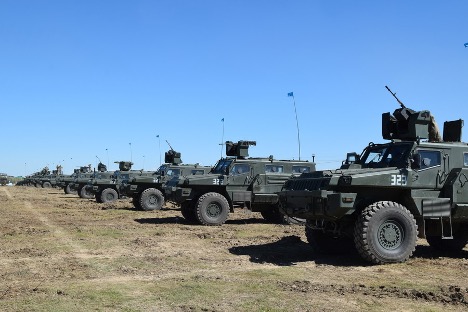COVID-19 and Indigenization of Industrial Capabilities: The Case of Arlan Armored Vehicles
Kazakhstan’s Ministry of Defence has ordered another batch of Arlan armoured vehicles from Kazakhstan Paramount Engineering (KPE), which will deliver them in 2021.
Paramount on 18 May said the Armed Forces of Kazakhstan have been operating the Arlan (based on Paramount’s Marauder) for more than three years, with multiple deliveries to the Kazakh Ministry of Defence and law enforcement agencies since August 2016.
The winterised Marauder has been designed to operate in extreme environments to meet the wide array of mission requirements undertaken by Kazakhstan’s armed forces, such as quick reaction force operations, infantry fire support or long-range border patrol, Paramount said.
The Arlan armoured vehicles are all locally manufactured (up to 70% local content) at the 15 000 square metre KPE armoured vehicle production facility in Nursultan, which employs more than 200 people. The facility has the capacity to produce more than two hundred armoured vehicles per year.
John Craig, Executive Chairman of Paramount Land Systems Group, stated, “The Coronavirus pandemic has highlighted the importance of security of supply during a global emergency. Now more than ever Governments are looking at the indigenisation of industrial capabilities in a bid to reduce exposure to global market volatility and uncertainty.
The portable manufacturing model that we have pioneered is designed for the creation of local manufacturing capabilities, anywhere in the world.
This model has thrived in Kazakhstan, where we have established a localised hub for indigenous, high-tech manufacturing and high-skills training that has enhanced job creation while supporting the defence capabilities of the nation for future decades.
“Our Team at Kazakhstan Paramount Engineering is continuing their steadfast and rapid production of advanced land systems technologies that excel in the extreme conditions and complex requirements of the region. Having been in operation with the Kazakh Armed Forces for more than three years, the Arlan has been tried and tested, and proven for its outstanding protection, ruggedness and mobility,” Craig said.
The Arlan features a double-skin monocoque, V-shaped hull structure that provides ballistic protection against 7.62 mm and 5.56 mm rounds, blast protection against mine explosions of 10 kg TNT beneath its hull or beneath any wheel and a 50 kg TNT side blast explosion.
The Arlan can carry a payload of up to 4 500 kg, reach a top speed of 120 km/h and ford depths of 1.2 metres. A pre-ignition engine heating and a dynamic temperature control system can carry personnel in winter conditions (as low as – 50 degrees Celsius) and summer temperatures (up to 50 degrees Celsius).
KPE also produces a number of other vehicles, including the Alan, which is the SandCat built under license from Israel’s Plasan. It can carry up to 11 people and provide protection up to STANAG Level 3.
It is based on a Ford F550 chassis and can reach speeds of up to 160 km/h. Kazakhstan originally purchased a number of SandCats from Oshkosh, which had partnered with Plasan. These were displayed in 2015.
KPE has also disclosed a number of developmental programmes, including a special operations variant of the Alan (the Alan 2), and a tracked infantry fighting vehicle called the Mergen.
This article was published by defenceWeb on May 18, 2020.

